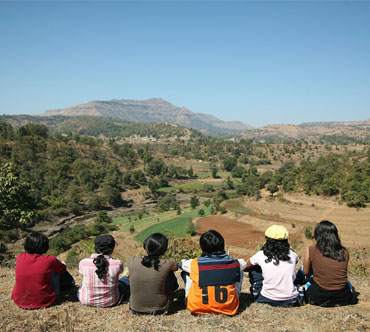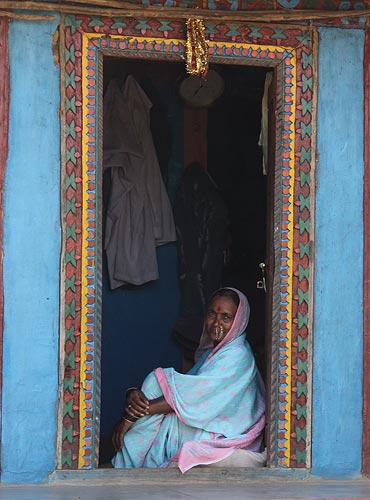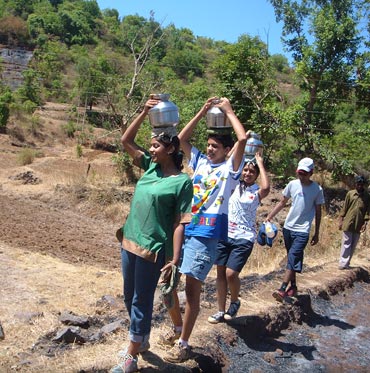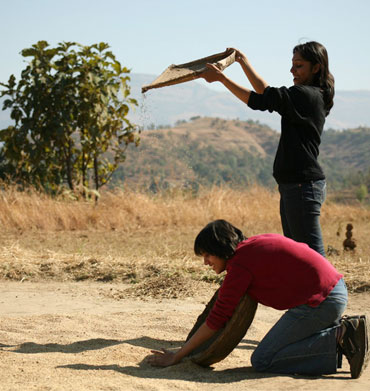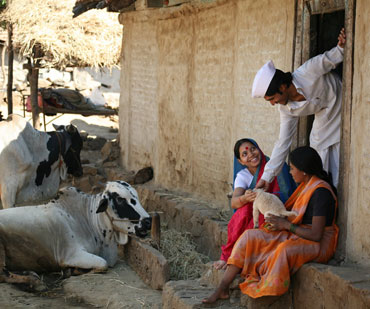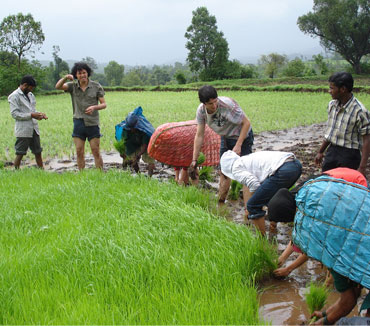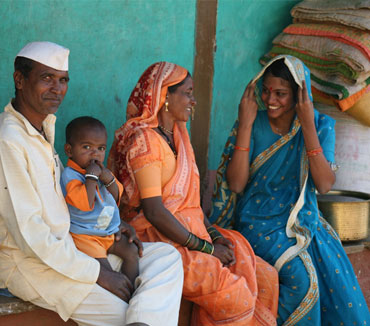 | « Back to article | Print this article |
XIM grad who dumped corporates for villages
Inir Pinheiro skipped placement offers after his MBA at the Xaviers Institute of Management in Bhubhaneshwar, to start up his own company, Grassroutes. The tourism initiative offers city dwellers a chance to holiday in India's villages and get acquainted with its distinct local culture.
Ploughing a rice field, or chasing a goat up a hillside might not be everyone's idea of a vacation. But for those of you who are looking for a different kind of holiday, Grassroutes might offer you just that!
"For India's brilliance to shine through, we need to address the basic lack of opportunity that people face here," says 29-year-old Inir Pinheiro. And that is what prompted him to set up Grassroutes, a social initiative that offers tourists a unique living experience through community-based tourism in rural Maharashtra.
"Grassroutes is an experiment for creating opportunities in rural India," he explains.
So what exactly does Grassroutes do? City dwellers sign up for a 2-day, 3-day, 4-day, or longer, trip on the website grassroutes.co.in, and choose the activities they'd like to participate in: all typical to village life. They then spend their holiday with a village family, learning about their customs, traditions and realities that are far removed from India's urban city life. The vibrancy of the indigenous arts, the value of labour in the fields, and the deep hospitality of an entire village community are just a flavour of what's on offer.
A "typical city boy", born and brought up in Mumbai, Inir learnt about the realities of village India much later. "It was quite by chance, that I happened to visit some villages. I found that even though I looked different, spoke a different language, I felt extremely secure, and never felt as if I had been left hungry or alone," he says. And this is what sowed the seed of his idea.
A postgraduate alumnus of Xavier Institute of Management (Bhubaneshwar), Inir passed up placements to pursue his vision. Grassroutes began in 2006 in the village of Purushwadi, as a private concern, and was registered in 2009. The organisation now works with three different villages in Maharashtra.
His innovative approach to addressing one of India's most daunting challenges (that of improving the lot of her villages and its inhabitants) while creating an economically viable commercial enterprise is what is winning Inir and his team accolades and recognition from various fronts.
His effort won him the Karamaveer Purashkar for Social Justice and Citizen Action in 2008. Here he speaks to Shifra Menezes about how Grassroutes came about and how he plans to grow Grassroutes into 200 villages by the year 2020.
Celebrating biodiversity
How did Grassroutes begin?
Through my journey from school to college, I came to realise that the biggest challenge that India faces is the lack of opportunity. It is this lack of opportunity that leaves people's energies to get digressed into crazy paths.
These discontent people (with no access to food, jobs, or social recognition) are mobilised into violence, or else, migration to cities. This is what has led to the dying of rural knowledge systems and indigenous cultures.
The villagers have always taken care of people. The entire issue, of how to conserve what we have, comes down to celebrating it. So if we celebrate the life of our villages, their biodiversity, their knowledge systems, we'll automatically be able to bring about conservation.
In order to bring about this kind of sustainability, we thought of creating an exchange platform between urban and rural communities, through community-based tourism.
What we have here today is the Grassroutes module where village tourism is managed, owned and run with the help of village communities themselves.
Nature, challenges, and rural communities
What's in it for the tourist?
City people can come and stay in a village for 2 to 4 days: plough fields, chop wood, pick fruits, chase goats up a mountain, eat organic food cooked over firewood, and share stories over bonfires.
Through this we encourage a connection between communities that are very different from each other. One suddenly begins to see the importance of a community.
You realise the importance of nature, and the challenges and opportunities that exist in rural India.
An unforgettable experience
How do city slickers adjust to village life?
On the whole, the response has been positive, but on a couple of occasions, adjusting to village food has been a hiccup.
For instance, one complaint was that the visitors didn't get tea at 6.30 am. When we asked the villagers why, they replied that tea was possible at 6.30 am but fresh milk only came at 7.30 am, so if the visitors wanted tea, it would have to be black. Or some people say they want eggs, and the villager says, 'Dhoondna padega'.
Having said that, we maintain a stock of food, bearing in mind that some people might be finicky about their food. So having a stock of Maggi helps.
Very few people complain about the experience they have at Grassroutes though. Imagine entering a village, and being welcomed by the entire village itself.
For example, there was an engagement ceremony in one of the villages and the tourists were invited and treated almost like guests of honour. So it is quite an unforgettable experience.
Or during the mango season, as you walk around the village, the villagers will simply come up to you and offer you mangoes to take home.
The high investment in community involvement is what makes this possible and incomparable to any other tourist experience.
How it works
So how does Grassroutes work?
Tourists gets in touch with us either by e-mail or phone. We then sit down and tailor a package for them.
We speak to the village committee and inform them of the number of people visiting and what activities to focus on -- nature-based activities, cultural programmes, adventure activities. They then meet the clients at a common point near the village.
We are the single point contact for financial transactions. That enables us to maintain quality in the villages, it also enables us to have village monitoring systems in place.
We are very strict on monitoring leakages -- tourists pay us and every rupee is tracked. We then pay the village committee within 15 days of the tourist visit along with feedback from the visit.
Tell us about the team.
John Nogueira, is a professional emcee and has the superb ability to relate to the villagers, he also heads our marketing effort.
Darren Lobo, a national level hockey player, joined us at 21 and his strength lies in his willingness to work with ambiguity. He spears our social media outreach, our operations and admin.
And then there's me, I'm left with the dirty work of generating finances.
How they got funding
What was the initial investment required and how did you fund it?
Grassroutes began under a prominent NGO called the Watershed Organsiation Trust. Rs 10 lakh was required for Purushwadi, subsequently Rs 5 lakh was required for Kohne. The Rs 10 lakh was got via a grant from a German funding agency, and from a Swiss agency for Kohne.
Unltd India, which incubates social ventures, has been funding us for the last couple of years. Until last year, our inflow from tourism covered for about 30 percent of our expenditure, the rest was financed through incubators and self-generated finance.
This year, around 70 percent will be coming in from tourism itself. So there has been substantial growth. We also recently won the Villgro award for social enterprise, so that gave us access to a certain amount of money.
Our module requires Rs 10 lakh to set up a village as a tourism destination. This we are currently mobilising through high net worth individuals via loans.
So we present these people with a profile of these villages, they select a village to support it financially themselves and through their professional networks and via publicity. The investor recovers his investment within a four-and-a-half-year period with 8 per cent interest.
The stakeholders
Tell us how the business model is structured.
There are four stakeholders involved in the current model of Grassroutes. The first is the village tourism committee, which is basically the representatives of villagers.
So every village has a committee with whom we negotiate the rates for specific activities, define food quality standards, tourist interaction standards, cleanliness and hygiene standards, etc.
The second is the investor who funds the setting up of the village as a tourism destination via debt.
The third is Grassroutes and the fourth is the local NGO that we tie up with for each village.
This NGO typically has rapport and an understanding of the village community and the trust of the villagers. They introduce us, we train the villagers and we also train the NGO on how to monitor the entire process.
So of every Rs 100 that comes in, Rs 30 goes to the village committee, Rs 30 goes to the investor as payback of the debt, Rs 30 goes to Grassroutes and Rs 10 to the NGO for helping monitor the village.
The challenges
What were the challenges you faced when you first began?
The difficulties lay on multiple fronts connecting with village communities and putting marketing systems in place. When it came to the village communities, they are predominantly agrarian-based and for us to get to a service industry base, it required massive encouragement of the villagers, motivating them.
We had to sit down with them and understanding their perspective. The people who were initially involved were really innovative and willing to experiment and that helped.
When we began in Purushwadi only four-five families volunteered to be trained. Today only in that village we work with over 70 families. So to try and get involved with more families in that village, to ensure transparent methods of payment, the first few families were made ambassadors of Grassroutes.
On the marketing front, there were a lot of misconceptions we had to deal with that villages were unsafe, there were snakes, that the meals provided would not be very good.
To get sustained market push its takes great effort to dispel these notions. (This year we have had about 600-700 tourists who have signed up). This year we should be touching 1,500 bed nights.
'Our aim is to get 200 villages on board by 2020'
How easy or difficult is it to get the word out?
The response has been brilliant but we still struggle from the lack of resources of getting the word out, marketing is still a bottleneck for us.
Our social media campaigns and mentions in the press help but it is still a challenge.
Our aim is to get 200 villages on board by 2020. To be able to do that we need to have that many customers. We have our work cut out for us.
How has Grassroutes fared so far?
We are currently working in three villages in Maharashtra -- Purushwadi and Kohne in the Bhandardhara region, and Walvanda in the Jawahar block. We plan to expand into four villages this year.
On one hand we are creating sustainable livelihood opportunities in villages, we have seen a 10-20 per cent increase in income in more than 50 per cent of the households in the villages that we work with. We track this information and document it. The rise in earnings leads to a reduction in migration, they see a massive increase in self-confidence in villagers.
Now when they talk to city people you see a pride there is a revival of their knowledge systems, in theatre, in local art.
This aspirational change happens not only in the village but also in the tourists, where city people begin to question their way of life, how they can get more nature in their life, how they can encourage sustainable living.
This connection between the urban and rural is leading to a change in the indifference of city people for village India. This is what we have been able to achieve.
So far we have been socially and environmentally sustainable. Now the effort of Grassroutes has also become triple bottomline sustainable, which is financially, social and environmentally sustainable. We are a for-profit venture.
For more information, visit www.grassroutes.co.in.
